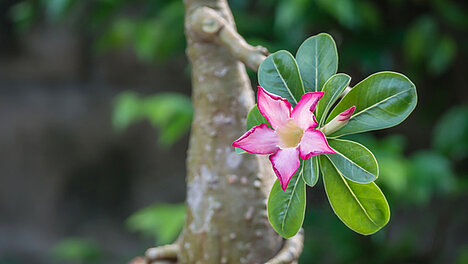Desert rose

The desert rose (Adenium obesum) is an exotic houseplant that delights many plant lovers with its pink flowers and thick trunk. But be careful: the desert rose belongs to the dog poison family and contains a white milky sap that can be very dangerous for dogs.
What is desert rose?
The desert rose is a type of plant that can be found in parts of Africa and on the Arabian Peninsula. It grows there in dry areas and stores water in its thickened trunk, which is also known as the caudex. The leaves are green, lanceolate and arranged alternately. The flowers are large, trumpet-shaped and usually pink or red in color. The desert rose blooms from April to September and can grow up to two meters high.
Why is desert rose poisonous to dogs?
Among other things, the desert rose contains cardenolides and hongheline, which are cardiac glycosides. These substances have an effect on the cardiovascular system and can lead to severe poisoning in dogs. The poisonous milky sap is released when the plant is injured, for example when repotting or pruning. If a dog nibbles on the plant or licks the latex, it can ingest the toxins.
What are the symptoms of poisoning?
The symptoms of desert rose poisoning can vary depending on the amount and type of ingestion. Possible signs are
- Vomiting
- diarrhea
- Irritation of the mucous membranes
- Stomach and intestinal cramps
- Cardiac arrhythmia
- shortness of breath
- collapse
- cardiac arrest
The symptoms can appear quickly or after a delay, depending on how quickly the toxins enter the bloodstream.
What to do if the dog has eaten desert rose?
If the dog has eaten desert rose or had contact with the latex, you should consult a vet immediately. There is no specific antidote for desert rose poisoning, so the vet will need to provide symptomatic treatment. This includes:
- Gastric lavage
- activated charcoal
- infusions
- Medication to stabilize the cardiovascular system
- Oxygen therapy
The faster the treatment is given, the better the chances are for the dog.
How can poisoning be prevented?
The best prevention is to remove the desert rose from the household or place it in such a way that the dog cannot reach it. You should also make sure that no milky sap escapes when repotting or pruning the plant or that you remove it immediately. If you take your dog for a walk, keep it away from wild desert roses. You should also always keep an eye on your dog and watch it for signs of poisoning.
The desert rose is a beautiful but poisonous plant for dogs. It contains cardiac glycosides, which can lead to severe poisoning. If the dog nibbles on the plant or licks the milky sap, a vet should be consulted immediately. To avoid poisoning, the desert rose should be removed from the household or made inaccessible.
If you notice any signs of hypersensitivity or poisoning in your dog, you should see your vet immediately. We are not a substitute for a vet, but we try to be as accurate as possible. Every dog reacts differently and we recommend you get a second opinion or consult your vet if in doubt.
Stay healthy and take good care of your four-legged friend!😊